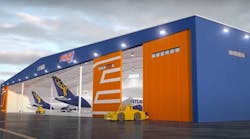In this month’s issue we look at several tools used in aircraft maintenance that are designed to make your operation more efficient. Kirk Baugher in his article titled Mobile Applications Drive Advancements in MRO Productivity describes how technology advancements have driven mobile apps to increase revenues, reduce costs, improve cycle times, and reduce the risks associated with adherence to compliance and quality mandates.
Paul Krupa describes how advances in abrasives technology with 3-D construction enables surface conditioning to fit into hard-to-reach places on aircraft in his article Plight of the Contour.
We also take a look at how visual inspection through modern day tools like videoscopes can enhance your inspection activity of hard-to-access areas and capture photos and video for future reference.
Tools don’t always come from the traditional toolbox these days. This month’s cover story by Jerome Chandler takes a look at how the military has followed civilian maintenance philosophy through cost-conscious concepts such as condition-based maintenance – another tool in today’s toolbox. His article titled Military Maintenance Adapts to New Realities describes how the mantra better, faster, less costly is increasingly embedded in the way military maintainers keep their aircraft flying longer and safer.
Last month’s issue of AMT was focused on work force development, recruitment and hiring trends, and a few advancements in maintenance training. AMT is pleased at the positive responses received from readers further supporting the fact AMT is the resource for current and upcoming aircraft maintenance professionals. As an add on to this Jerome Chandler also describes some of the U.S. Army’s initiatives (tools) to keep young maintainers or Millennials engaged in learning through use of virtual training aids.
On the business aviation front, Jim Sparks in his article The Business of Maintaining a Business Aircraft offers a flight department’s aircraft need to be viewed as a corporate asset. As such these assets must be managed accordingly. It only makes sense that maintaining and managing this valuable asset is a responsibility of those responsible for continued airworthiness.
Neil Brackin, Director, Air Transportation for General Mills, Inc., couldn’t agree with Jim more. In this Corporate Flight Department profile, Brackin describes how aircraft technicians today have taken on the role and responsibilities of being an aircraft maintenance manager, requiring special skills (more tools) in the areas of maintenance planning, proposals and cost analysis, budgeting, and the very important involvement in managing an operator’s safety program.
New responsibilities and changing roles mean new tools. The tools of many of today’s maintainers come from seeking knowledge and continued education and AMT is another item in your toolbox.
Enjoy the issue, Ron


